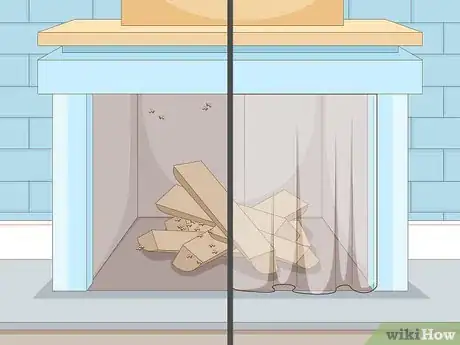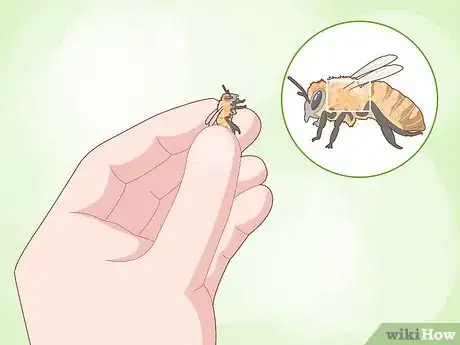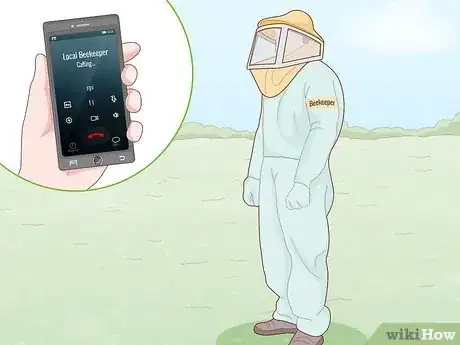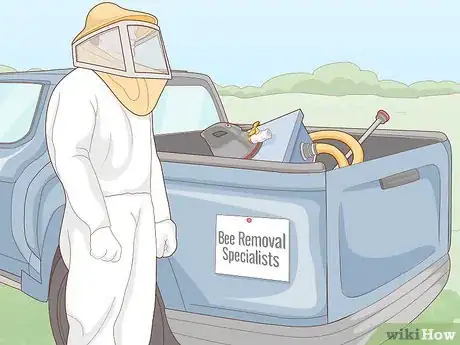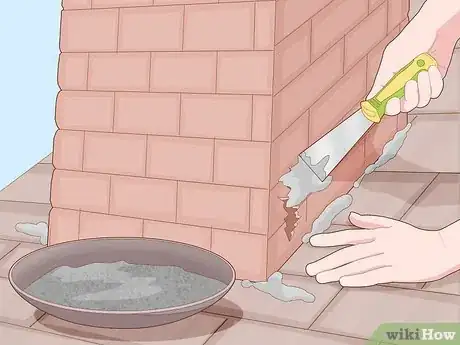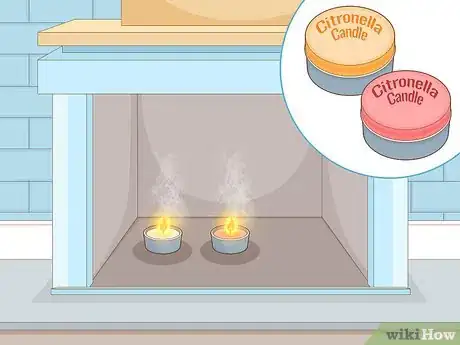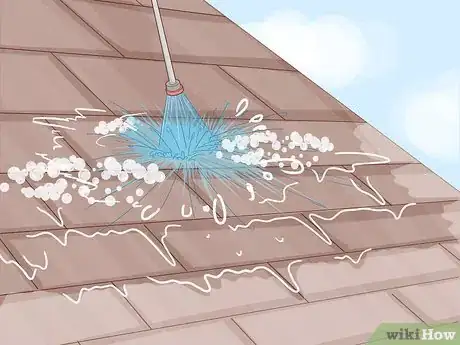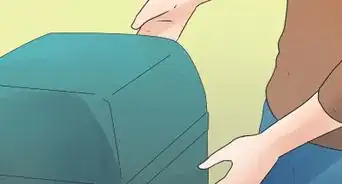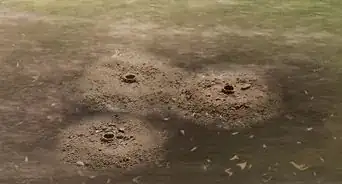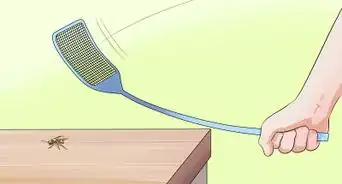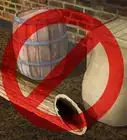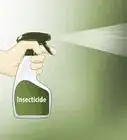This article was co-authored by Steve Downs and by wikiHow staff writer, Eric McClure. Steve Downs is a Live Honey Bee Removal Specialist, Honey bee Preservationist, and the Owner of Beecasso Live Bee Removal Inc, a licensed bee removal and relocation business based in the Los Angeles, California metro area. Steve has over 20 years of humane bee capturing and bee removal experience for both commercial and residential locations. Working with beekeepers, agriculturalists, and bee hobbyists, Steve sets up bee hives throughout the Los Angeles area and promotes the survival of bees. He has a passion for honeybee preservation and has created his own Beecasso sanctuary where rescued bee hives are relocated and preserved.
There are 11 references cited in this article, which can be found at the bottom of the page.
wikiHow marks an article as reader-approved once it receives enough positive feedback. In this case, 87% of readers who voted found the article helpful, earning it our reader-approved status.
This article has been viewed 145,893 times.
There’s nothing better than sitting by the fireplace on a cool night with a warm beverage. Unfortunately, the chimney is a perfect oasis for bees, and the warm, secluded area can look like a great place for bees to establish a colony. Since removing the bees yourself would involve wearing a beekeeper’s outfit on a roof with nowhere to run from an attacking swarm, this isn’t realistically something that you should do on your own. Contact a beekeeper or bee removal company to remove the hive, and stay away from hiring an exterminator if possible. Bees are generally non-aggressive and they’re incredibly good for the environment, so you should do everything in your power to avoid killing all of them.
Steps
Assessing the Problem and Plugging the Chimney
-
1Keep your fireplace off if you suspect you have a bee problem. If you suspect that there are bees in your chimney, do not start your fireplace under any circumstance. Beeswax is highly flammable, and you may risk an explosion if you turn it on. Even if a major blast doesn’t occur, the hot wax may eat through your grout and masonry, potentially causing extensive damage. On top of that, bees are good for the environment! You may be able to have them peacefully removed without killing any bees in the process.[1]
Warning: Removing bees from your chimney is not something that you can reasonably do on your own. This process requires getting on the roof in a beekeeper’s outfit and leaning down into the chimney. Even if you anchor yourself properly, you could get stung and potentially fall from the roof. You’ll also have nowhere to run if the bees attack.
-
2Confirm that you have bees by looking for fur and round thoraxes. If you see dead insects in the pit of your fireplace or there are bugs flying around your chimney, see if you can confirm that they’re bees. Bees always have fur, while wasps and hornets have smooth exteriors. In addition, hornets and wasps have longer, thinner thoraxes while bees tend to be round.[2]
- If you have hornets or wasps in your nest, call an exterminator and seal your chimney immediately. Hornets and wasps can be very aggressive towards humans, and if they think your home is their home, you could have a nasty situation on your hand.
- If you have an allergy to bees, do not get close to them. Bees are typically non-aggressive, but they may sting if they think you’re trying to harm them.
Advertisement -
3Use an infrared camera to determine if they’ve established a hive. Rent an infrared camera from a construction supply store. Turn the camera on and point it at the fireplace. Slowly raise it up towards your roof while monitoring the screen. If there are lots of little dots flying around, you have bees. If there is a large, white mass on the screen, you have a hive.[3]
- An infrared camera will cost around $50-80 to rent for a day.
- If the bees haven’t established a hive, it will cost considerably less to have the bees removed. The contractor will likely use a vacuum to extract the bees and take them elsewhere. This will usually cost anywhere from $50-200.
- If you have an established hive, it will cost a little more. The contractor will need to use a grinder to cut the hive out and remove it. This can cost $200-1,500, depending on the size of the hive and the chimney.
-
4Plug your chimney if it’s open to keep the insects from coming inside. Get an inflatable chimney plug from a construction supply store. Inflate the plug halfway by blowing into the tube. Then, slide it up the pit until it’s at least 1 ft (30 cm) above the base of the chimney. Next, blow it up as much as you can to expand the plug and block the chimney. This is the best way to keep bees, wasps, or hornets from flying down into your home.[4]
- The damper, which is the hatch that closes the opening to the chimney, is not nearly enough to keep bees out. They can usually squeeze through the opening between the plates.
- Chimney plugs are also known as balloon plugs.
- Alternatively, hold a contractor’s bag over the chimney and press long lengths of duct tape into the seam where the bag meets the masonry. Then, add more tape along the groves in the grout so it overlaps the seam where the first layer of tape meets the masonry. Do this 2-3 times to create an airtight fit.
EXPERT TIPSteve Downs is a Live Honey Bee Removal Specialist, Honey bee Preservationist, and the Owner of Beecasso Live Bee Removal Inc, a licensed bee removal and relocation business based in the Los Angeles, California metro area. Steve has over 20 years of humane bee capturing and bee removal experience for both commercial and residential locations. Working with beekeepers, agriculturalists, and bee hobbyists, Steve sets up bee hives throughout the Los Angeles area and promotes the survival of bees. He has a passion for honeybee preservation and has created his own Beecasso sanctuary where rescued bee hives are relocated and preserved.Live Bee Removal Specialist
 Steve Downs
Steve Downs
Live Bee Removal SpecialistOur Expert Agrees: If you have bees in your chimney, keep the bees from entering your home by taping a large black trash bag around the entrance. Also, when you're investigating the chimney to determine where the bees are located, wear full protective attire and have a smoker on hand to protect yourself from stings.
Hiring a Professional
-
1Contact local bee rescues and beekeepers to see if they can take the hive. Ideally, you won’t need to kill the bees. Start by calling local swarm rescues and beekeepers. Explain your situation to them to see if they have experience removing bees from chimneys. Swarm rescues and beekeepers will use a vacuum to remove the bees and relocate them elsewhere. This is the best way to handle the bees in your chimney since it doesn’t require killing them.[5]
- If there is a hive and it’s deep down in your chimney, bee rescues and beekeepers will likely be unable to help remove it. They will get the majority of the bees out safely though, which will make the job much easier for the bee removal company.
- Expect to spend less than $200 to have a beekeeper or rescue remove the bees. Some groups and beekeepers won’t even charge you though, since you’re technically doing them a favor.
Tip: Regardless of the method you choose in this section, removing bees from a chimney can take 3-5 days. This is a fairly complex job.
-
2Hire a bee removal company that clears chimney hives if necessary. If there is an established hive and the beekeepers or rescues aren’t available, hire a bee removal company. They will do their best to safely remove most of the bees with a vacuum or trap. Then, they will use a crow bar and grinding wheel to extract the physical honeycombs that make up the hive. They may need to remove some of the bricks in the chimney, so be wary that this may get expensive.[6]
- Depending on the size of the hive and the amount of masonry that needs to be removed, a bee removal company may charge you anywhere from $200-1,500. It really depends on the size of the hive and chimney, though.
- Bee removal companies often save as many bees that they can and sell them to local honey producers or beekeepers.
-
3Contact an exterminator if the hive cannot be removed. If there are no bee removal companies in your area, hire an exterminator that has experience with chimneys. The exterminator will pour a powdered insecticide down the chimney and cleanse the chimney. They will use special excavation tools to destroy the hive and remove the leftover honeycombs.[7]
- Most exterminators should have no problem clearing a chimney.
- The exterminator will unfortunately kill the bees, but it beats having an active colony in your chimney and it’s really the only option if there are no humane ways to remove.
- An exterminator’s services are fairly comparable to a bee removal company. It will usually cost $200-300, but it may run over $1,500 if the hive is particularly large or the chimney is especially difficult to access.
Keeping the Bees from Returning
-
1Hire roofers to repair the chimney and keep bees out in the future. Once your chimney is free of bees, hire a chimney repair company to replace the grout and close up any gaps in the masonry. If you don’t have any flashing on the chimney, have them install some. It’s possible that the bees bore holes into the grout inside, so repairing your chimney and reinforcing it is the best way to keep bees from returning in the future.[8]
- Depending on the shape that your chimney is in, this may cost anywhere from $500-2,500. It really is the best way to prevent bees from returning in the future, though.
Tip: Have the roofing company install a chimney cap with thin wire on the sides to keep bugs from coming into the chimney in the future. Even if you don’t want to get the chimney repaired, it’s necessary to install one of these caps to keep future colonies out.[9]
-
2Burn citronella candles in your fireplace periodically to keep bees out. Bees absolutely cannot stand the scent of citronella. Every week or so, burn 1-2 citronella candles in the fireplace. Even if the smoke doesn’t make it all the way through the chimney, the smell should be more than enough to keep bees from settling down.[10]
- It can take bees a while to build a hive, so doing this regularly during the warmer months is a great way to keep the bees from living permanently in your chimney.
-
3Rinse your gutters, roof, and walls with soapy water to deter bees. Fill a spray bottle halfway with warm water. Fill the other half with dish soap. Shake the bottle to mix the water and soap up. Then, spray your gutters, shutters, siding, and exterior walls. Bees will actively avoid soap residue, since it clogs their skin and makes it difficult for them to breathe. This is a great way to keep bees from hanging out around your roof.[11]
- Do this once every 1-2 weeks during the warmer months to keep bees from settling in your home.
- Planting peppermint in your garden is also a great way to keep bees away. They’re less likely to set up shop in your home if your garden isn’t particularly appealing.
Community Q&A
-
QuestionWhom do I contact to help get rid of the bees?
 Community AnswerYou can contact a pest control service to help with removal.
Community AnswerYou can contact a pest control service to help with removal. -
QuestionWhat kind of bees are there?
 LaKayla FloodCommunity AnswerThere are Apidae, Andrenidae, Megachilidae, Sweat Bees, Colletidae, Melittidae, Carpenter Bee, Bumble Bee, Honey Bee, Stenotritidae.
LaKayla FloodCommunity AnswerThere are Apidae, Andrenidae, Megachilidae, Sweat Bees, Colletidae, Melittidae, Carpenter Bee, Bumble Bee, Honey Bee, Stenotritidae. -
QuestionHow long do bees usually hang around?
 Shibesh DhunganaCommunity AnswerBees will usually hang around for a year or two, but it depends on the bees. Some species of bees make temporary colonies whereas some make more permanent colonies.
Shibesh DhunganaCommunity AnswerBees will usually hang around for a year or two, but it depends on the bees. Some species of bees make temporary colonies whereas some make more permanent colonies.
Warnings
- Unless you’re a professional beekeeper or roofer, you should not be messing around on your roof if there are stinging insects. You could risk being swarmed with nowhere to run, or worse, end up falling off of the roof.⧼thumbs_response⧽
Things You’ll Need
Assessing the Problem and Plugging the Chimney
- Chimney plug
- Infrared camera
Keeping the Bees from Returning
- Citronella candles
- Dish soap
- Water
- Spray bottle
References
- ↑ https://columbiametro.com/article/the-birds-the-bees-and-chimney-disease/
- ↑ https://www.bbc.co.uk/newsround/45194754
- ↑ https://nypost.com/2019/11/13/un-bee-lievable-long-island-couple-living-with-monster-hive-of-120000-bees/
- ↑ https://youtu.be/xoDht9wcxG4?t=18
- ↑ https://www.bbka.org.uk/swarm
- ↑ https://www.bbka.org.uk/Handlers/Download.ashx?IDMF=bbee6581-dd54-4906-8e17-417e44c1332e
- ↑ http://ipm.ucanr.edu/PMG/PESTNOTES/pn74159.html
- ↑ https://www.jlconline.com/how-to/insulation/sealing-a-chimney-chase_o
- ↑ https://repository.arizona.edu/bitstream/handle/10150/578402/az1677-2015.pdf?sequence=1&isAllowed=y
